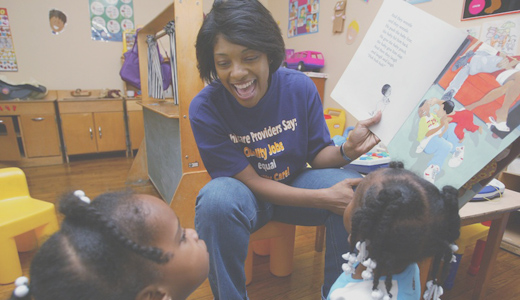

ILCA, Second Place, Best Analysis
Black women are playing significant roles in shaping the direction of emerging social movements, movements that affect the criminal justice system and the rights of working people across the country. Black Lives Matter and Fight for $15 are just two of the influential campaigns intersecting with labor that African American women are leading. As African American civil rights and human rights activist Ella Baker once said, “Wherever there has been struggle, Black women have been identified with that struggle.” This holds just as strongly today.
As the elections loom, the continued right-wing attacks on labor and working people’s hard-won gains show that there is much at stake. According to the Bureau of Labor Statistics (BLS), some of the fastest growing occupations with the greatest increase in job opportunities projected through 2024 will be in the healthcare, retail trade, and food services sectors. These are industries increasingly being filled by black women. The service sector is 27 percent African-American women. Black women have also had a steady increase in union membership since 2002 at 15.7 percent (after seeing a drop from 1985 to 2000). And although union membership declined sharply among men in 2002 (from 22.1 to 14.7 percent) there was a steady increase among women, thanks in part to the jump in union membership of Black women in 2002. It is clear from these statistics alone that the only way the labor movement will survive and thrive for the next eight to ten years is if labor takes a proactive stance in investing in Black women’s leadership.
As Black women lead the charge for equal rights and a better standard of living for working-class and poor people, they face intense marginalization and oppression. A 2015 study by the U.S. Department of Labor found that Black mothers have had the highest labor force participation rates historically. That year, Black mothers with children under 18 participated in the labor force at a rate of 76.3 percent. This is higher in comparison to their white (69.6 percent), Asian (at 60.2 percent), and Hispanic (61.6 percent) counterparts.
Despite Black women’s willingness to work, this demographic still faces a significant wage gap and is more likely to work in lower paid occupations such as fast food, retail, and the service industry. As the BLS reports, among major occupational groups, the highest percentage of hourly paid workers earning at or below the federal minimum wage was in service occupations, at about 10 percent. Black women food service workers also earn only 60 percent of the salaries that their male counterparts earn.
Unequal treatment begins in girlhood
This inequality is not only the case once they join the labor force, but recent studies have found that it begins as soon as they enter the education system. Two new studies, one by The National Women’s Law Center and the other by the African American Policy Forum (AAPF), have compiled damning evidence on how the educational system treats African-American girls. They show that Black girls are being overpoliced and underprotected from an early age. If organized labor expects to build a pipeline of strong Black women leaders, it must not only tackle the disparities in employment, but also those in the education system.
The African American Policy Forum’s study, entitled Black Girls Matter: Pushed Out, Overpoliced, and Underprotected, found that while significant research has been conducted on how the school-to-prison pipeline affects Black and Latino boys, “existing research, data, and public policy debates often fail to address the degree to which girls face risks that are both similar to and different from those faced by boys.” The study’s authors conclude that when attention is not given to the plight of Black girls within the educational system, “educators, activists, and community members remain under-informed about the consequences of punitive school policies on girls” and the environments that limit the girls’ educational achievements.
Policing and punishment were a major focus of the AAPF study. It found that the increased levels of law enforcement and security personnel within schools can often make girls feel less safe and thus less likely to attend school. Another finding was that not using restorative responses in place of punitive responses contributes to the disproportionate numbers of Black girls in the juvenile justice system. In addition, Black girls experience high incidents of interpersonal violence and sexual harassment.
The Black Girls Matter authors further conclude that, in order to deal with the challenges being faced by Black girls, a concentrated effort is needed to explode two myths: one, that all young people of color in crises are boys; and two, that the experience of white girls in schools is indistinguishable from the experience of girls of color. According to the study, neither stereotype is supported by the evidence. In connection with the public release of its report, AAPF launched the ongoing social media campaign Black Girls Matter to encourage the public to get involved in bringing attention to the often ignored topic of the oppression of African-American girls under the educational system. Some of the recommended tweets included, “Resist the narrative that our girls are alright,” and “Our girls are suffering. Does anyone care?”
The study by the National Women’s Law Center (NWLC) on the same issue supports AAPF’s assertions. Unlocking Opportunity for African-American Girls: A Call to Action for Educational Equity describes not only the oppression that African American girls face but highlights how, like their older counterparts in the workforce, Black girls have been at the forefront of social change, in this case in particular to the educational system. The study’s authors write: “Behind many of the most important battles for racial and gender equality in the United States–from school desegregation to sex discrimination–are African-American girls. From the pioneers in school desegregation, such as Linda Brown and Barbara Johns, to the advocates for legal protections against student-on-student sexual harassment, like LaShonda Davis, African-American girls have played significant roles in ensuring the availability of meaningful educational opportunities for everyone.” And just like their older counterparts who have been on the front lines in the fight for social justice, the challenges that they face often have gone ignored, the study notes.
Some of the study’s findings include:
The suspension rate of Black girls is six times higher than the suspension rate of white girls, and also higher than white, Asian, and Latino boys.
African-American girls represent 17 percent of the female student population but make up 31 percent of all girls referred to law enforcement and 43 percent of girls who experienced a school-related arrest.
High school graduation rates for African-American girls are lower than for all other girls except Native American girls.
Monique W. Morris, a veteran education, civil-rights, and social-justice scholar, and co-founder of the National Black Women’s Justice Institute, cites many of the same types of statistics found in the studies in her popular book Pushout: The Criminalization of Black Girls in Schools. In a recent interview with The Atlantic regarding her work, Morris noted that when people read the bleak statistics they often wonder “What did these girls do” to deserve such punishments. Yet, Morris notes, that isn’t the question to ask. Rather, she states, “it’s not about what they did, but rather, the culture of discipline and punishment that leaves little room for error when one is Black and female.”
The authors of the NWLC’s report further note that the cycle of disparity continues after high school as 40 percent of African-American women under the age of twenty-five without a high school diploma find themselves living in poverty. As the authors note, touching on the statistic that Black women are often the sole providers of their household, “Without intervention, they and their families, many of whom depend on women as primary breadwinners, can experience poverty and other consequences of limited educational attainment.”
The study’s authors explain that policymakers must take a proactive stance in investing in the future of African-American girls. One of the proactive measures the study suggests is to require schools to adopt and publicize strong anti-harassment policies. Another recommendation was the need to support leadership development among African-American girls.
Labor’s role
Despite the tough odds, there have been African-American women who have come up in the ranks to provide effective leadership in labor and other social justice movements. Black Lives Matter co-founder and Oakland, Calif., resident Alicia Garza is a leader of the National Domestic Workers Alliance’s (NDWA) “We Dream in Black” campaign. This campaign organizes housekeepers, nannies, and caregivers for the elderly, and has helped to secure basic rights such as maternity leave and paid time off state-by-state for these workers. NDWA explains that the campaign is aimed to “strengthen and expand our base of Black domestic workers and amplify their historical and current contributions to the broader domestic worker movement. Given the legacy of Black women in domestic work, and the ongoing ways in which race shapes the conditions and experiences of workers, NDWA has prioritized building strong organizing projects rooted in Black communities.”
Phelicia Jones, a member of SEIU local 1021, has been a key coordinator in the Justice for Mario Woods Coalition, a group that continues to seek justice for those slain by police violence in the San Francisco Bay Area and beyond. The coalition recently succeeded in achieving one of their demands – to have SFPD Police Chief Suhr resign from his position after another police shooting of an African-American woman. Carmen Berkley and Tiffany Dena Loftin, both young Black women, have been leading the work in the Civil, Human and Women’s Rights Department of the AFL-CIO.
Although these are examples of Black women who have beat tremendous odds in order to emerge in leadership, there could be many more if groups such as organized labor decided to invest in and build a pipeline for young women of color to enter into leadership.
As Berkley pointed out to People’s World at the AFL-CIO executive council meeting on Feb. 22 when speaking on the need to address racial tensions within labor, “None of this is to diminish the leadership of white workers. It’s actually a way to strengthen the ability of the leadership to reflect the diversity of their membership.” Black women are a large part of the growing and ever changing labor force in the U.S. In order to have a strong front against the increased attacks on the livelihood of working people, it is crucial for current labor leadership to advocate for cultivating the leadership of women of color. To advocate for that leadership means to combat the continued oppression that Black women face–not only when they join the workforce but when they enter kindergarten. The exploitation faced on the job by these women is not the beginning but merely a reinforcement of oppression that begins as soon as they enter the educational system as young girls. Facts and figures have shown that African-American women are some of the toughest fighters when it comes to workers’ rights, but who is fighting for them? If organized labor doesn’t have the backs of Black women, it can expect to fade away as the jobs continue to increase in the service economy. The labor movement won’t survive if Black women aren’t supported to thrive.
Photo: Childcare worker and children. AP












Comments